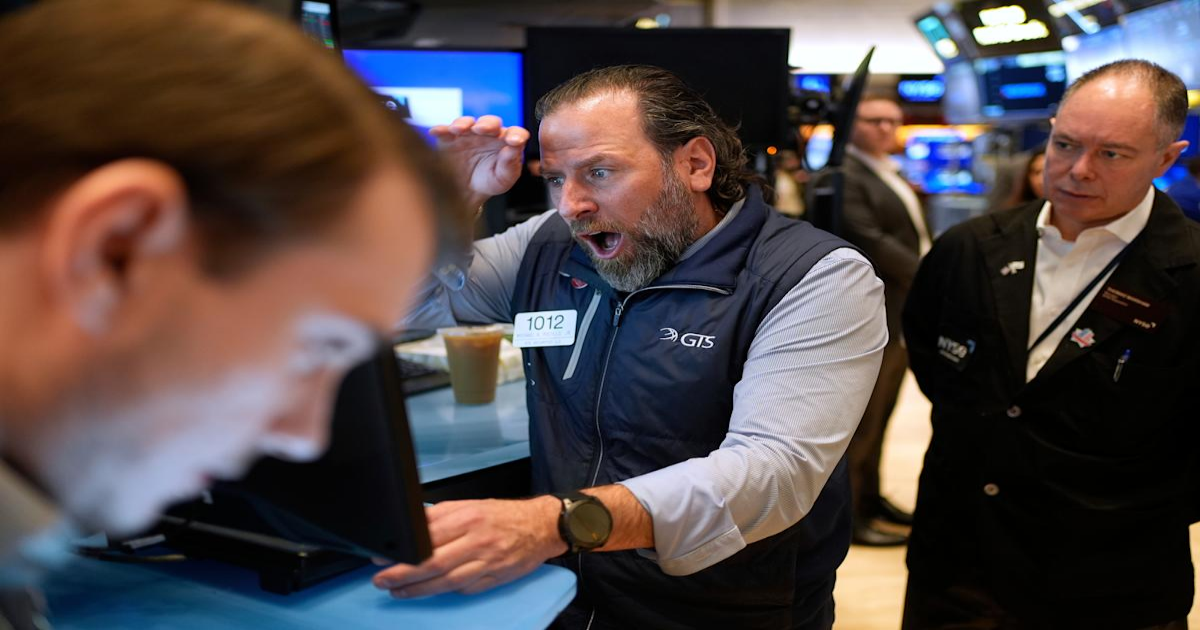It’s been one of the most chaotic stretches for US markets in recent memory.
The S&P 500 (^GSPC) has fallen more than 10% in just three days. The three-day collapse in stocks following President Trump’s tariff announcement sits just below the top 10 worst sell-offs since World War II, per Yahoo Finance data.
The only three-day periods that brought stocks lower came in 1987, 1998, 2008, 2011 and 2020.
On Monday, the S&P gained roughly 8% in less than 30 minutes on a false report that President Trump was considering a 90-day pause on his tariff rollout. The White House quickly denied the reports, categorizing any potential tariff pause as “fake news.”
The trading action showed how chaotic global markets have become since Trump announced plans to spike the US tariff rate to its highest level in more than a century.
The S&P 500 is now on the brink of a bear market, down about 17% from its most recent all-time high. Many of the largest stocks in the market are all off more than 20% from their most recent all-time highs. Oil prices have cratered to their lowest level in nearly four years, and overseas markets have suffered under the weight of the impact.
Below are some of the most eye-popping charts from one of Wall Street’s most aggressive sell-offs in the past 100 years.
On April 2, Trump laid out his long-awaited plans to slap reciprocal tariffs on countries around the world, with the new levies ranging from a 10% “baseline” tariff to additional duties for nations the administration considers to be the “worst offenders.”
All told, Trump announced tariffs that will impact some 185 countries, including the United States’s largest trading partners. Additional reciprocal tariffs, for instance, will include 34% tariffs on Chinese imports, a 20% tariff on European Union imports, a 46% tariff on imports from Vietnam, 32% on imports from Taiwan, and 26% on India — all set to take effect on April 9.
In the latest escalation of his trade war, Trump threatened China with an additional 50% tariff if Beijing did not remove the retaliatory 34% levies on US imports the country announced last week.
Other countries have begun to announce their own retaliations and negotiation plans with the US as investors brace for more pain over the coming days and weeks.
Just as the “Magnificent Seven” stocks helped lead the bull market higher over the past two years, the market’s leaders have been at the forefront of the massive leg lower too.
A combination of Apple (AAPL), Alphabet (GOOGL, GOOG), Microsoft (MSFT), Amazon (AMZN), Meta (META), Tesla (TSLA), and Nvidia (NVDA) lost over $1 trillion from their collective market caps in the first session following the tariff announcements.
Even after some slight rallies on Monday, every stock in the cohort is still off roughly 5% in the past four sessions.
As the selling action began to settle on Monday, investors were greeted with an ugly picture. Less than 20% of stocks in the S&P 500 are above their 200-day moving average.
The 200-day moving average is a commonly cited technical level that shows a stock’s average trading price over the last 200 days. This chart helps reflect how indiscriminate this sell-off has been. Very few members of the S&P 500 have held up through the crash.
Oil prices have dropped about 15% over the last five days as investors worry Trump’s tariffs will cause a recession and crimp demand.
In early trade on Monday, West Texas Intermediate (CL=F) futures briefly dropped below $60 per barrel for the first time since 2021 before trimming losses to settle at $60.70.
Brent (BZ=F), the international benchmark, also declined over 1% to close at $64.21 per barrel.
Some analysts see more room for prices to fall. Goldman Sachs once again reduced its full-year price targets for both Brent and WTI, trimming estimates by another $4 on Sunday.
Goldman forecasts Brent to end 2025 at an average price of $62 a barrel and WTI crude prices at $58.
“We reduce our oil price forecast further as we incorporate our economists’ GDP downgrades from the last few days, including the forecast of a stagnating US economy,” Daan Struyven, Goldman Sachs co-head of global commodities research, wrote in a note Sunday night.
While the tariffs would brought on by the US, the global market is feeling the pain too.
There’s perhaps no better example of how aggressive recent sell-offs have been than the massive move seen in Japan’s Nikkei index (^N225).
The broad index of Japanese equities tanked nearly 8% on Monday. Futures tied to the index were halted at one point due to all the selling, one of the few circuit-breaking events seen amid the global scramble of the past few days.
Josh Schafer is a reporter for Yahoo Finance. Follow him on X @_joshschafer.
Click here for the latest stock market news and in-depth analysis, including events that move stocks
Read the latest financial and business news from Yahoo Finance
